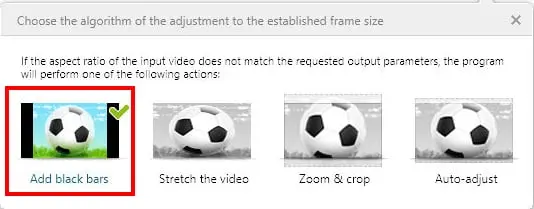Most users use presets for “iPhone” or simply “MP4” while transcoding videos. However, employing them may result in poor video quality or excessively large files that use a lot of your phone’s capacity. You need to know what the term means if you want to be more precise about things like resolution, bitrate, and aspect ratio. So to get better results when converting videos, there are many things to get this!
What we will see here?
Resolution
You’ll start with a large, high-quality file if to get better results when converting videos to a 4K origin, such as a GoPro. Let’s pretend you’d want to watch the video on your phone. Even if your smartphone can play it, it’s pointless to keep the video’s full resolution of 3096×2160.

Enter the screen resolution of your smartphone in your video converter. This will lower the size of the final video file, as well as make it seem better on your phone by preventing the phone from downscaling the video to fit.
Aspect ratio
This conveniently takes us to the aspect ratio. The aspect ratio of the 1080p video is 16:9. The result of dividing 16 by 9 is 1.77, which is the same as splitting 1920 by 1080. Divide the resolution of your phone’s longest dimension by its shorter side to determine its aspect ratio.
Some of the most recent phones have 18:9 (or 2:1) displays, which are twice as large as they are high.

You may lose information (slicing off the sides or top and bottom) or acquire black bars at the sides or top and bottom whenever you convert video and it has a difference in aspect ratio than the original.
Although each video converter is unique, it should provide you with the ability to modify the aspect ratio.
Frame rate
The number of video frames taken video content per second is proven as the frame rate. In the United Kingdom, you will have a 25fps standard (PAL) (frames per second). Video with a frame rate of 24 frames per second is in use in every movie. Unless your device can’t play the video at its normal frame rate, we recommend keeping the framerate alone. The first Apple TV, for comparison, can only show 720p video (1280720 resolution) at 24 frames per second.
Container
The words codec, as well as container, are commonly the terms from which everyone gets confused. One explanation for this is that a codec and its container, such as MP4, might have the same name (MPEG-4).
Simply put, the container is a method of combining audio and video into a single file. It’s similar to a zip file in that it may store a variety of files in different formats. Containers include.MP4,.MKV,.AVI,.MOV,.OGG, and. ASF, among others.
Codec
An audio file as well as a video file are both held within a video container. The way through which each one was shrunk is given by a codec.
An . AVI container, for example, may store DivX video plus MP3 music files. MPEG-4 video, as well as AAC audio, may both be found in.MP4 files. The.MKV container, which supports H.264 video and AAC audio, is one of the most used formats for HD video. However, the most recent is H.265 which can be used for the majority of 4K videos since it is significantly more efficient than H.264 and results in fewer files without sacrificing quality. you can also use it to transmit 4K content, and it’s compatible with almost all 4K TVs.
The MPEG-4 video codec is indeed the best for the great majority of purposes, including Android and iOS devices. To be more exact, H.264 (sometimes you call it MPEG-4 AVC) is more efficient than ordinary MPEG-4, therefore picking H.264 will provide you with the highest picture quality for the least file size. It’s sometimes referred to as x264 by video converters.
Bitrate-
A container file’s video and audio have their very own bitrates. The bitrate is a measurement of how many bits are sent in a certain amount of time. The basic line would be that the bigger the number of bits in your movie, the higher the visual quality.
Bitrate is commonly in Mbps (megabits per second) for video. Blu-ray discs generally have a bitrate of 20 to 30 megabits per second. That’s far too fast for a tablet or smartphone, which can barely handle 2 to 5 megabits per second.
Bitrate is proportional to file size; multiply the bitrate even by the video’s runtime to get the approximate file size. Don’t forget to provide the audio’s bitrate and length. The bitrate of audio is substantially lower than that of video, usually just under 320Kb/s (kilobits per second). 1 megabit per second equals 1,000 megabits per second.
To determine the best bitrate for your device, you’ll have to explore it. If you set it too low, you’ll get a little file with poor quality, especially if there’s a lot of action on the screen.
Constant vs variable bitrate
You may choose between a variable or fixed bitrate. Which adds to the complexity. You might (or may not, depending upon your video converter) be able to define a min and max bitrate with variable bitrate. The encoder then attempts to condense the video as effectively as possible, utilizing the lowest bitrate when there is little or no motion and the highest bitrate when the entire frame is moving.
The benefit is that you must get a better quality video with just a smaller file size after converting it. But if you’re streaming the video over the internet, the variable bit rate isn’t always the greatest option.
The term “fixed bit rate” refers to a video’s bit rate remaining consistent throughout. Smoother playback results in excessive at the price of a bigger file.
You may need to experiment to determine what works better on the device you’re seeing the video on.
If you’re unclear about your device’s video requirements, consult the user guide or conduct an internet search.
Is it possible to convert a video without losing its quality?
You have two options. The first is to utilize a low compression setting. This improves the overall quality of your movie, but it does not cut the file size as much as conventional compression. The second choice is to enlarge or reduce the size of your video.
How can you compress a video online without sacrificing quality?
Compressing huge video files to a lower file size without sacrificing visual quality is possible. MP4, MPEG, HD video files, and all other video streaming movie file formats are compatible. VEED allows you to reduce your files online right now. There is no need to download any program.
Which video compressor is the most effective?

Here are some of the best and most effective video compressors:
Movavi Video Converter is a program that converts video files.
Ultimate Video Converter by VideoSolo.
Compressor for Final Cut Pro X.
VSDC.
Convert free.
Freemake Video Converter is a free video converter.
Video Compressor by Media.io.
VLC Media Player is a free media player.
Conclusion
If you are a newbie editor then we guess that you are suffering from a situation where your recorded video does not have the same quality as the original after converting it. So to overcome this there are really a ton of actions that you can go from and made your video quality better, and one of the solutions is here. So follow this instruction to get better results when converting videos.
Read more:
- How to use Workflow for iOS when you don’t know where to start?
- How to convert pdf to word?
- Save an Email as a PDF on your iPhone, iPad and Mac!
- Best Ultrawide Monitor: Increase Your Performance, Games, and Video Views!
- How to convert JPG to PDF?
















